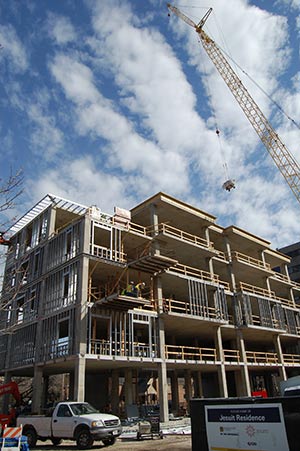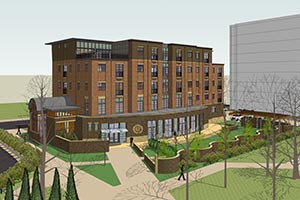A new building is taking shape on the Marquette University campus, thanks in part to the support of a $5 million donation and two separate $1 million donations.
Groundbreaking took place last July for a new Jesuit residence on campus and in the months that have followed, the  Construction continues Monday, March 16, a sidewalk on the five-story Jesuit Residence being built on the Marquette University campus. The building will have 25 resident rooms, five guest rooms and a chapel with an outside entrance to allow individuals from the outside to enter. (Catholic Herald photo by Ricardo Torres) skeleton of the building in the 1400 block of West Wells Street is evident.
Construction continues Monday, March 16, a sidewalk on the five-story Jesuit Residence being built on the Marquette University campus. The building will have 25 resident rooms, five guest rooms and a chapel with an outside entrance to allow individuals from the outside to enter. (Catholic Herald photo by Ricardo Torres) skeleton of the building in the 1400 block of West Wells Street is evident.
The $5 million donation was from an alumni couple, Ray and Kay Eckstein, through their charitable trust. One $1 million gift came from the Bernice Shanke Greiveldinger Charitable Trust; the other was anonymous.
The fundraising effort totaled $15 million, including an anonymous lead gift of $10 million, with $7.5 million dedicated to the Jesuit residence and the remainder going to need-based scholarships, according to a March 19, 2014, press release from Marquette.
Shanke Greiveldinger, who died March 27, 2008, was a 1942 graduate of Marquette’s School of Journalism. She worked for 43 years at the then-Milwaukee Journal in the advertising department. She followed in the footstpes of her brother, Edwin, who graduated from Marquette in 1932, also in journalism. He was a foreign correspondent for the Associated Press, based in Berlin, Germany, and later in London and Stockholm, during and after World War II.
“Our current building is deteriorating and is much larger than what we will need in the future,” Jesuit Fr. James Kubicki, 11-year resident at Marquette, told the Catholic Herald last summer. “The new building, I think, will be a place that will stand out to clearly identify the university as a Catholic Jesuit university.”
Fr. Kubicki said while living in the residence for the last few years he noticed problems with the infrastructure, plumbing and just overall deterioration throughout the building.
The new five-story building, designed by Kubala Washatko Architects, will have 25 resident rooms and five guest rooms. It will also feature a chapel with an entrance on the sidewalk – as opposed to being in the center of the building – to allow outside individuals to use it.
“The Jesuit presence is also an essential part of the mission of education at Marquette University,” Fr. Kubicki said. “People will be able to recognize that this is a holy place where people receive not only an intellectual education, but an education that is based on faith values.”
 An artist’s rendering shows the new Jesuit Residence on the Marquette University Campus. The building was designed by Kubala Washatko Architects. The campus houses more than 40 Jesuit residents and the building is referred to by students and faculty as the “Jes Res.”
An artist’s rendering shows the new Jesuit Residence on the Marquette University Campus. The building was designed by Kubala Washatko Architects. The campus houses more than 40 Jesuit residents and the building is referred to by students and faculty as the “Jes Res.”
Marquette president Michael Lovell said he wants the Jesuit community to continue to have a visual presence on the campus.
“We have a 130-year history of having world class Jesuit scholars at Marquette University that have been vital in transforming hundreds of thousands of lives,” Lovell told the Catholic Herald at the time of the groundbreaking.
He added the new residence will give back to Jesuit residents, past and present, who have provided the university with years of support.
“It provides the Jesuit community with a facility that matches the quality of the Jesuit family we have on our campus,” Lovell said.
The residence will be 40,000 square feet and is being built between Alumni Memorial Union and Schroeder Hall.
Jesuit Fr. Tom Lawler, resident and provincial superior of Wisconsin province of the Society of Jesus, said it’s refreshing to have this much-needed change.
“We will now become more visible on campus and more accessible to the students, faculty and staff,” Fr. Lawler said. “People see the (current) building but they rarely understand what goes on in there, who lives there and what we do … we’re sort of invisible on (Marquette) campus.”
Michael VanDerhoef, vice president for university advancement, said the new facility will help the Jesuits achieve their mission.
“Pope Francis has won the admiration of millions around the world in large part due to his accessibility,” VanDerhoef said. “He has led by example in remarkable ways when it comes to connecting with the people.”
VanDerhoef said the ability for Jesuit priests to be more visible and available to students, faculty and staff, will expand with this building.
“Our new, more accessible residence at the campus will help us to follow (Pope Francis’) same leadership style,” VanDerhoef said.
The residence will also be LEED (Leadership in Energy and Environmental Design), something Vanderhoef considers important in the university’s support for the sustainability movement.
The campus will include more green space this summer after the current residence is razed, said Vanderhoef.
“Green space, which is a precious commodity on an urban campus,” he added.
Fr. Lawler said the building project has given the university “a sense of new life and better understanding of the Jesuit presence.”
“It’s something new and exciting,” Fr. Lawler said.
